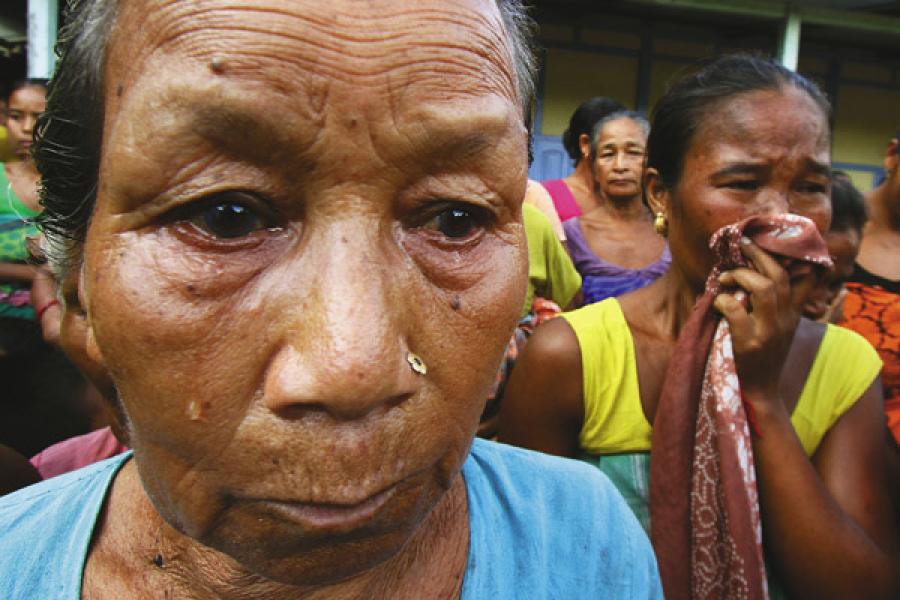
State-led Peace Deals Led to Assam Violence
State-negotiated accords have only managed to empower ethnic elites, creating new fissures and shrinking democracy
Yet another cycle of violence has erupted in the multi-ethnic, multi-religious and multi-lingual Northeast, a “frontier” region that historically, socially and spatially has had only a tenuous connection with India. Bordering Bangladesh, Myanmar and China, the naturally well-endowed region is riven by land, language, religion and identity conflicts.
For the past several weeks, ethnic and communal violence has engulfed the Bodo tribal homeland, claiming more than 60 lives and putting to flight 400,000 people in the Bodo Territorial Autonomous Districts (BTAD) area in lower Assam.
The recent conflict is a reminder of the legacy of South Asia’s integrated geographies and economies and the movement of people that produces enduring anxieties over illegal migrants outnumbering the natives.
This cycle of violence pits indigenous Bodo tribes against people of Bengali origin and Bangladeshi migrants. The communal frame of Muslim victimisation distorts bitter contests over land and Bodo anxieties over losing their autonomous homeland, wrested from the Assamese through armed insurrection.
The violence also lays bare the deep flaws in the government’s strategy of resolving violent ethno-nationalist assertions through peace deals that deliver territorial “homelands” to ethnic elites through power sharing arrangements in autonomous or federal units.
The cycles of endemic violence prove that these top-down peace processes do not address the issues that drive the conflict, nor do they improve the quality of life of the people.
A grassroots, rights-focussed study of the Chittagong Hill Tracts (CHT) Accord (1997), the Mizo Accord (1986), Naga Peace Accords (1947-1997), Bodo Accords (1993, 2003), Madhes Accords (2007-2011) and Balochistan (non-accord) by the South Asian Forum for Human Rights (SAFHR) shows that such state-tailored peace processes do not empower struggling communities. Often, peace deals are power sharing arrangements for the elites, rarely culminating in plural politics or more just and inclusive societies.
Analysis of negotiations reveals that there is little intent or capacity to address the grievances which drive conflicts.
The Assam Accord (1985), for instance, focusses on the core issue of detection of “foreigners” but never produced any effective mechanism to check the influx of Bangladeshi migrants.
As a senior government negotiator disclosed, the only issue that mattered was getting the “democratic” Assam movement’s leaders to come to power. A quarter of a century later, peace talks are still on, now with the armed group United Liberation Front of Assam (ULFA).
Most people surveyed by SAFHR do not believe that these deals contribute to peace. Barely 22 percent thought the accord could build sustainable peace, 24 percent saw it reinforcing the status quo and 24 percent called it eyewash. The majority of respondents across five conflict-affected areas believed the accord’s major contribution was controlling violence.
The process of negotiations itself fragments, rather than unites, because the state chooses when and with whom to talk. The 2003 Bodo Accord signed with the Bodo Liberation Tigers (BLT) split the ethnic minority and the section which was excluded from the negotiations grouped under the National Democratic Front of Bodoland (NDFB).
NDFB is now in a separate dialogue with the government. It undermined the authority of BLT leaders in controlling the BTA Council, which diverted funds to fight turf wars with NDFB and gave it an incentive to crank up violence levels to force the state to negotiate with it.
Autonomy was intended to expand grassroots democracy, but the studies showed democracy shrinking. The Bodo, Tripura, Darjeeling/Gorkha and CHT Accords envisaged creating self-governing councils. Instead, they have either perpetuated interim non-elected bodies or, as in Bodoland, allowed the non-rehabilitated ex-armed cadres of the BLT to capture electoral processes.
The structure of power institutionalised in these ethnic homelands disadvantages non-dominant minorities. In Bodoland, though the Bodos have become a minority (35 percent of the population) in several segments of the ethnically delimited BTA, the power structure is weighted five to one in favour of the Bodo tribes, disadvantaging non-Bodo “minorities”.
Anxieties over loss of autonomy, minoritisation and land fuelled inter-ethnic violence in 1994, 1996, 1998, 2008 and 2012 targeting the more vulnerable non-Bodo communities–Santhals and “illegal” Muslims–hundreds of thousands of whom are still in “permanent” refugee camps.
The peace deals creating autonomous ethnic territories have not only failed to empower marginalised communities, but have also torn up the multi-ethnic character of these regions, leading to new conflicts. Xenophobic reactions have given rise to new movements for separate homelands such as the Bodo movement (Assam), Hmar assertion (Mizoram), Koch Rajbhonshis and Muslims (Bodoland), Tharus (Madhes-Nepal) and Pashtuns (Balochistan). Equal rights of citizenship have failed to break down systemic inequalities, producing a politics of quotas and competing ‘ethnic’ homelands.
Peace in ethnic homelands is routinely disrupted by endemic cycles of violence that disrupt governance and undermine initiatives such as the potentially transformative “Look East policy”.
But it is premised on our states finding effective and sustainable strategies in resolving conflicts.
Rita Manchanda is senior research director at SAFHR and a former journalist
(This story appears in the 31 August, 2012 issue of Forbes India. To visit our Archives, click here.)
-
 Monjib
MonjibWhat does BTA means in your article? It is would be unwise to assume that the author has thorough knowledge of the current situations in Assam. If he is not sure of even some simple facts like the BTC (BTA as the author writes) what arguments can he put forward to justify that peace accords led to violence in Bodoland? It is quite ridiculous that the prestigious magazines is publishing such a cheap opinion pieces.
on Aug 16, 2012















